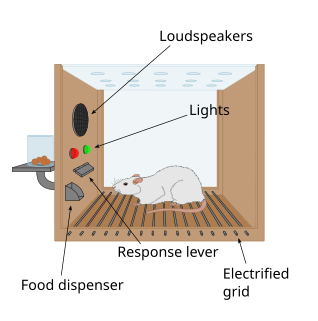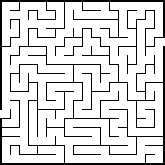
Burrhus Frederic Skinner was an American psychologist, behaviorist, author, inventor, and social philosopher. He was a professor of psychology at Harvard University from 1958 until his retirement in 1974.
Operant conditioning is a type of associative learning process through which the strength of a behavior is modified by reinforcement or punishment. It is also a procedure that is used to bring about such learning.

An operant conditioning chamber is a laboratory apparatus used to study animal behavior. The operant conditioning chamber was created by B. F. Skinner while he was a graduate student at Harvard University. The chamber can be used to study both operant conditioning and classical conditioning.
Classical conditioning is a behavioral procedure in which a biologically potent stimulus is paired with a previously neutral stimulus. It also refers to the learning process that results from this pairing, through which the neutral stimulus comes to elicit a response that is usually similar to the one elicited by the potent stimulus.
Robert Bolesław Zajonc was a Polish-born American social psychologist who is known for his decades of work on a wide range of social and cognitive processes. One of his most important contributions to social psychology is the mere-exposure effect. Zajonc also conducted research in the areas of social facilitation, and theories of emotion, such as the affective neuroscience hypothesis. He also made contributions to comparative psychology. He argued that studying the social behavior of humans alongside the behavior of other species, is essential to our understanding of the general laws of social behavior. An example of his viewpoint is his work with cockroaches that demonstrated social facilitation, evidence that this phenomenon is displayed regardless of species. A Review of General Psychology survey, published in 2002, ranked Zajonc as the 35th most cited psychologist of the 20th century. He died of pancreatic cancer on December 3, 2008 in Palo Alto, California.
State-dependent memory or state-dependent learning is the phenomenon where people remember more information if their physical or mental state is the same at time of encoding and time of recall. State-dependent memory is heavily researched in regards to its employment both in regards to synthetic states of consciousness as well as organic states of consciousness such as mood. While state-dependent memory may seem rather similar to context-dependent memory, context-dependent memory involves an individual's external environment and conditions while state-dependent memory applies to the individual's internal conditions.

Latent learning is the subconscious retention of information without reinforcement or motivation. In latent learning, one changes behavior only when there is sufficient motivation later than when they subconsciously retained the information.
John Bascom Wolfe was an American social and behavioural psychologist best known for his study of the use of a token economy on chimpanzees.
Behavioral contrast refers to a change in the strength of one response that occurs when the rate of reward of a second response, or of the first response under different conditions, is changed. For example, suppose that a pigeon in an operant chamber pecks a key for food reward. Sometimes the key is red, sometimes green, but food comes with equal frequency in either case. Then suddenly pecking the key when it is green brings food less frequently. Positive contrast is seen when the rate of response to the red key goes up, even though the frequency of reward in red remains unchanged. Likewise, increasing the reward to green tends to reduce the response rate to red. This sort of contrast effect may occur following changes in the amount, frequency, or nature of the reward, and it has been shown to occur with various experimental designs and response measures.
Willard Stanton Small was an experimental psychologist. Small was the first person to use the behavior of rats in mazes as a measure of learning. In 1900 and 1901, he published journal two of three in "Experimental Study of the Mental Processes of the Rat" in the American Journal of Psychology. The maze he used in this study was an adaptation of the Hampton Court Maze, as suggested to him by Edmund Sanford at Clark University.
In psychology, a drive theory, theory of drives or drive doctrine is a theory that attempts to analyze, classify or define the psychological drives. A drive is an instinctual need that has the power of driving the behavior of an individual; an "excitatory state produced by a homeostatic disturbance".
A habit is a routine of behavior that is repeated regularly and tends to occur subconsciously.
Kenneth Wartinbee Spence was a prominent American psychologist known for both his theoretical and experimental contributions to learning theory and motivation. As one of the leading theorists of his time, Spence was the most cited psychologist in the 14 most influential psychology journals in the last six years of his life. A Review of General Psychology survey, published in 2002, ranked Spence as the 62nd most cited psychologist of the 20th century.
The Kerplunk experiment was a famous stimulus and response experiment conducted on rats and demonstrates the ability to turn voluntary motor responses into a conditioned response. The purpose of the experiment was to get kinaesthetic feedback rather than guidance through external stimuli through maze learning. It was conducted in 1907 by John B. Watson and Harvey A. Carr and was named after the sound the rat made after running into the end of the maze. The study would help form a chain of responses hypothesis proposed by Watson.
Purposive behaviorism is a branch of psychology that was introduced by Edward Tolman. It combines the objective study of behavior while also considering the purpose or goal of behavior. Tolman thought that learning developed from knowledge about the environment and how the organism relates to its environment. Tolman's goal was to identify the complex cognitive mechanisms and purposes that guided behavior. His theories on learning went against the traditionally accepted stimulus-response connections at this time that were proposed by other psychologists such as Edward Thorndike. Tolman disagreed with Watson's behaviorism, so he initiated his own behaviorism, which became known as purposive behaviorism.
Tryon's Rat Experiment is a psychology experiment conducted by Robert Tryon in 1940 and published in the Yearbook of the National Society for Studies in Education.
Miles Albert Tinker was an American author. He is "an internationally recognized authority on legibility of print" who published the results of some of the most comprehensive studies on the legibility of print ever conducted. According to Jeremy York, Tinker's work, along with his colleague Donald G. Paterson, "was a driving force behind the standardization of the print industry in the United States".
Inequity aversion in animals is the willingness to sacrifice material pay-offs for the sake of greater equality, something humans tend to do from early age. It manifests itself through negative responses when rewards are not distributed equally between animals. In controlled experiments it has been observed, in varying degrees, in capuchin monkeys, chimpanzees, macaques, marmosets, dogs, wolves, rats, crows and ravens. No evidence of the effect was found in tests with orangutans, owl monkeys, squirrel monkeys, tamarins, kea, and cleaner fish. Due to mixed results in experimental studies it may be that some bonobos, baboons, gibbons, and gorillas are inequity averse. Disadvantageous inequity aversion is most common, that is, the animal protests when it gets a lesser reward than another animal. But advantageous inequity aversion has been observed as well, in chimpanzees, baboons and capuchins: the animal protests when it gets a better reward. Scientists believe that sensitivity to inequity co-evolved with the ability to cooperate, as it helps to sustain benefitting from cooperation.
Leo P. Crespi (1916–2008) was an American psychologist who directed public opinion research for the United States Information Agency.
Association in psychology refers to a mental connection between concepts, events, or mental states that usually stems from specific experiences. Associations are seen throughout several schools of thought in psychology including behaviorism, associationism, psychoanalysis, social psychology, and structuralism. The idea stems from Plato and Aristotle, especially with regard to the succession of memories, and it was carried on by philosophers such as John Locke, David Hume, David Hartley, and James Mill. It finds its place in modern psychology in such areas as memory, learning, and the study of neural pathways.


